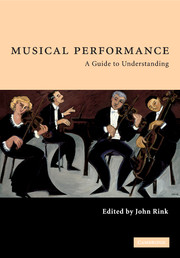11 - Ensemble performance
Published online by Cambridge University Press: 05 June 2012
Summary
Ensemble performance involves musical and social interaction between a group of performers. The term ‘ensemble’ derives from the French for ‘together’, and it defines the seemingly infinite array of musical performances involving more than one person, ranging from a duo to a symphony orchestra. At the same time, ‘ensemble’ refers to the precision with which musicians perform together: a good group is often praised for its ‘tight’ ensemble work, whereas an inferior one might have ‘sloppy’ ensemble.
Our experience of ensemble performance can be enhanced by realising some of the processes involved in making music together. This chapter considers four aspects in particular: coordination, communication, the role of the individual and social factors. Most of the observations refer to small chamber groups within the Western art tradition, but reference will also be made to larger ensembles on occasion.
Coordination: keeping time
The most fundamental requirement of any ensemble is that the individual parts fit together. It is necessary, therefore, for each musician to be able to perform in time with the rest of the group; indeed, the coordination of an ensemble is all about timing. Any accomplished ensemble performer knows that counting is vital in order to keep time, at least to realise which beat is being performed and when to enter or exit. There are, however, further matters to consider with regard to the coordination of timing, and three will be discussed in this section: the ensemble's clock, timekeeping skills and the illusion of synchrony.
Information
- Type
- Chapter
- Information
- Musical PerformanceA Guide to Understanding, pp. 153 - 167Publisher: Cambridge University PressPrint publication year: 2002
References
Accessibility standard: Unknown
Why this information is here
This section outlines the accessibility features of this content - including support for screen readers, full keyboard navigation and high-contrast display options. This may not be relevant for you.Accessibility Information
- 31
- Cited by
